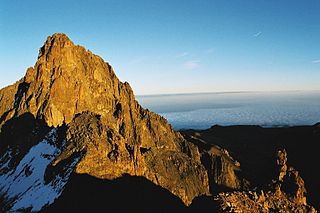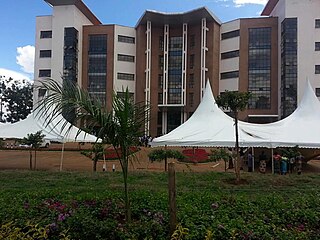Related Research Articles

A part of Eastern Africa, the territory of what is known as Kenya has seen human habitation since the beginning of the Lower Paleolithic. The Bantu expansion from a West African centre of dispersal reached the area by the 1st millennium AD. With the borders of the modern state at the crossroads of the Bantu, Nilo-Saharan and Afro-Asiatic ethno-linguistic areas of Africa, Kenya is a truly multi-ethnic state. The Wanga Kingdom was formally established in the late 17th century. The kingdom covered from the Jinja in Uganda to Naivasha in the East of Kenya. This is the first time the Wanga people and Luhya tribe were united and led by a centralized leader, a king, known as the Nabongo.

The Mau Mau rebellion (1952–1960), also known as the Mau Mau uprising, Mau Mau revolt, or Kenya Emergency, was a war in the British Kenya Colony (1920–1963) between the Kenya Land and Freedom Army (KLFA), also known as the Mau Mau, and the British authorities. Dominated by Kikuyu, Meru and Embu fighters, the KLFA also comprised units of Kamba and Maasai who fought against the European colonists in Kenya, the British Army, and the local Kenya Regiment.

The Kikuyu are a Bantu ethnic group native to East Africa Central Kenya. At a population of 8,148,668 as of 2019, they account for 17.13% of the total population of Kenya, making them Kenya's largest ethnic group.

Mount Kenya is an extinct stratovolcano in Kenya and the second-highest peak in Africa, after Kilimanjaro. The highest peaks of the mountain are Batian, Nelion and Point Lenana. Mount Kenya is located in the former Eastern and Central provinces of Kenya; its peak is now the intersection of Meru, Embu, Kirinyaga, Nyeri and Tharaka Nithi counties, about 16.5 kilometres south of the equator, around 150 km (90 mi) north-northeast of the capital Nairobi. Mount Kenya is the source of the name of the Republic of Kenya.
Ogiek is a Southern Nilotic language of the Kalenjin family spoken or once spoken by the Ogiek peoples, scattered groups of hunter-gatherers in Southern Kenya and Northern Tanzania. Most Ogiek speakers have assimilated to cultures of surrounding peoples: the Akie in northern Tanzania now speak Maasai and the Ogiek of Kinare, Kenya now speak Gikuyu. Ndorobo is a term considered derogatory, occasionally used to refer to various groups of hunter-gatherers in this area, including the Ogiek.
The Yaaku are a people who are said to have lived in regions of southern Ethiopia and central Kenya, possibly through to the 18th century. The language they spoke is today called Yaakunte. The Yaaku assimilated a hunter-gathering population, whom they called Mukogodo, when they first settled in their place of origin and the Mukogodo adopted the Yaakunte language. However, the Yaaku were later assimilated by a food producing population and they lost their way of life. The Yaakunte language was kept alive for sometime by the Mukogodo who maintained their own hunter-gathering way of life, but they were later immersed in Maasai culture and adopted the Maa language and way of life. The Yaakunte language is today facing extinction but is undergoing a revival movement. In the present time, the terms Yaaku and Mukogodo, are used to refer to a population living in Mukogodo forest west of Mount Kenya.

The Aberdare Range is a 160 km (99 mi) long mountain range of upland, north of Kenya's capital Nairobi with an average elevation of 3,500 metres (11,480 ft). It straddles the counties of Nyandarua, Nyeri, Muranga, Kiambu and Laikipia. The mountain range is located in west central Kenya, northeast of Naivasha and Gilgil and lies just south of the Equator. The mountain range is called Nyandarua among the Agikuyu people in whose territory this forest and mountain range is located. The name Nyandarua comes from the Kikuyu word rwandarua meaning a drying hide, due to the distinctive fold of its silhouette.

The Meru or Amîîrú are a Bantu ethnic group that inhabit the Meru region of Kenya. The region is situated on the fertile lands of the north and eastern slopes of Mount Kenya in the former Eastern Province.
The Agumba people were an ethnic group who inhabited the forests of Mount Kenya, but are now either extinct or assimilated.

The Okiek, sometimes called the Ogiek or Akiek, are a Southern Nilotic ethnic group native to Tanzania and Southern Kenya, and Western Kenya. In 2019 the ethnic Okiek population was 52,596, although the number of those speaking the Akiek language was as low as 500.

Presbyterian Church of East Africa (PCEA) is a Presbyterian denomination headquartered in Nairobi, Kenya. In Kenya, 10% of the population is Presbyterian. It was started by missionaries from Scotland, most notable of whom was Dr John Arthur. It has its headquarters in Nairobi South C.

Chuka is a town on the eastern slopes of Mount Kenya, in Kenya about 65 km south Of Meru Town. It falls within Tharaka-Nithi County and the former Eastern Province. Between 1992 and 2009, Chuka was the capital of Tharaka Nithi District. Tharaka Nithi District was further split into Meru South and Tharaka Districts with Chuka remaining the Capital of Meru South. Later, Meru South and Tharaka were amalgamated into Tharaka-Nithi County.

The campaign against female genital mutilation in colonial Kenya (1929–1932), also known as the female circumcision controversy, was a period within Kenyan historiography known for efforts by British missionaries, particularly from the Church of Scotland, to stop the practice of female genital mutilation in colonial Kenya. The campaign was met with resistance by the Kikuyu, the country's largest tribe. According to American historian Lynn M. Thomas, female genital mutilation became a focal point of the movement campaigning for independence from British rule, and a test of loyalty, either to the Christian churches or to the Kikuyu Central Association, the largest association of the Kikuyu people.
The Lumbwa were a pastoral community which inhabited southern Kenya and northern Tanzania. The term Lumbwa has variously referred to a Kalenjin-speaking community, portions of the Maa-speaking Loikop communities since the mid-19th century, and to the Kalenjin-speaking Kipsigis community for much of the late 19th to mid-20th centuries.
Mbwaa is an origin narrative of the Meru peoples of Kenya. It is a widely told tale that has been narrated for at least three centuries. These traditions have been widely linked to the Shungwaya origin narrative. However it has been noted that a number of inconsistencies appear in the telling of this narrative. It thus may be, a conflation of two or more peoples origin narratives. Indeed subsequent events in the narrative lead up to the assimilation of two peoples, referred to as Muku-Ngaa and Murutu, both of whom contribute to the present Meru identity.
Mutai is a term used by the Maa-speaking communities of Kenya to describe a period of wars, usually triggered by disease and/or drought affecting widespread areas of the Rift Valley region of Kenya. According to Samburu and Maasai tradition, two periods of Mutai occurred during the nineteenth century. The second Mutai lasted from the 1870s to the 1890s.
The Ngaa people were a community that according to the traditions of many Kenyan communities inhabited regions of the Swahili coast and the Kenyan hinterland at various times in history.
The Murutu people were a community that, according to the oral literature of the Meru people of Kenya, inhabited regions of the Swahili coast and the Kenyan hinterland at various times in history.
The Burkineji were a pastoral community who inhabited regions of northern Kenya through to the late 19th century. The present day Samburu consider themselves a descendant community of the Burkineji.
Archibald Clive Irvine was a Scottish medical missionary to Kenya. He was an early proponent to stopping female circumcision. He worked primarily in Chogoria, Kenya, where he introduced coffee cultivation. He was the founder of the PCEA Chogoria Hospital and is the namesake of the Clive Irvine College of Health Sciences on the slopes of Mount Kenya. Clive also started the Chogoria Girls and Boys schools.
References
- 1 2 3 Fadiman, J. (1994). When We Began There Were Witchmen. California: University of California Press. pp. 69–70.
- ↑ Fadiman, J. (1994). When We Began There Were Witchmen. California: University of California Press. pp. 67, 69, 75. ISBN 9780520086159.
- ↑ Fadiman, J. (1994). When We Began There Were Witchmen. California: University of California Press. p. 75. ISBN 9780520086159.
- 1 2 3 4 Defense Technical Information Center (1983). Area Handbook Series Kenya, A Country Study. DA: The American University. p. 7.
- ↑ Fadiman, J. (1994). When We Began There Were Witchmen. California: University of California Press. p. 69. ISBN 9780520086159.
- ↑ Fadiman, J. (1994). When We Began There Were Witchmen. California: University of California Press. p. 77.